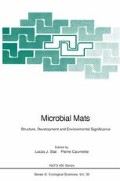Abstract
The shortest wavelengths of the solar spectrum reaching the ground, known as the solar ultraviolet (UV, 280–400 nm), amount to only a small percentage of the total incident irradiance (Table 1). However, they may produce disproportionately large biological effects because they activate many photochemical reactions involving molecules of central biological importance. The consequence of these photoreactions is usually detrimental to the cellular metabolism. Mutation and lethal DNA and RNA damage, lipid peroxidation, photoinhibition of photosynthesis and respiration, and specific enzyme inactivation can all be a result of exposure to UV (Jagger 1985). These physiological effects are not always a laboratory curiostity but have ecological implications under natural conditions: the solar UV has been recognized as an important environmental stress factor in a variety of microbially dominated ecosystems. UV has been shown to cause sustained inhibition of both primary productivity and bacterial production in planktonic communities and to drive marked changes in species composition in periphyton communities (see Worrest 1982), but not much is known about the significance of ultraviolet radiation in benthic ecosystems. We have gathered some direct experimental evidence, as well as strong indirect inference from ecophysiological studies in diverse mat communities, suggesting that UV may be of importance, at least for the top phototrophic layers.
Access this chapter
Tax calculation will be finalised at checkout
Purchases are for personal use only
Preview
Unable to display preview. Download preview PDF.
References
Donkor V, Häder DP (1991) Effects of solar ultraviolet radiation on motility, photo-movement and pigmentation in filamentous gliding cyanobacteria. FEMS Microbiol Ecol 88: 159–168
Garcia-Pichel F, Castenholz RW (1991) Characterization and biological implications of scytonemin, a cyanobacterial sheath pigment. J Phycol 27: 395–409
Garcia-Pichel F, Castenholz RW (1993) Occurrence of UV-absorbing, mycosporine-like compounds among cyanobacterial isolates and an estimate of their screening capacity. Appl Environ Microbiol 59: 163–169
Garcia-Pichel F, Sherry ND, Castenholz RW (1992) Evidence for a UV sunscreen role of the extracellular pigment scytonemin in the terrestrial cyanobacterium Chlorogloeopsis spp. Photochem Photobiol 56: 17–23
Garcia-Pichel F, Wingard CE, Castenholz RW (1993) Evidence regarding the UV-sunscreen role of a mycosporine-like compound in the cyanobacterium Gloeocapsa sp. Appl Environ Microbiol 59: 170–176
Hirosawa T, Myachi S (1983) Effect of long-wavelength ultraviolet (UV-A) radiation on the growth of Anacystis nidulans. Plant Sci Lett 28: 291–298
Jagger J (1985) Solar-UV actions on living cells. Praeger.
Ohki K, Watanabe M, Fujita Y (1982) Action of near UV and blue-light on the photocontrol of phycobiliprotein formation; a complementary chromatic adaptation. Plant Cell Physiol 23: 651–656
Vosjan JH, Pauptit E (1992) Penetration of photosynthetically available light (PAR), EV-a and UV-b in Admiralty Bay, King George Island, Antarctica. Circumpolar J 1–2: 50–58
Worrest RC (1982) Review of the literature concerning the impact of UV-B radiation on marine organisms. In: Calkins J (ed) The role of solar radiation in marine ecosystems. Plenum Press
Author information
Authors and Affiliations
Editor information
Editors and Affiliations
Rights and permissions
Copyright information
© 1994 Springer-Verlag Berlin Heidelberg
About this paper
Cite this paper
Gareia-Pichel, F., Castenholz, R.W. (1994). On the significance of solar ultraviolet radiation for the ecology of microbial mats. In: Stal, L.J., Caumette, P. (eds) Microbial Mats. NATO ASI Series, vol 35. Springer, Berlin, Heidelberg. https://doi.org/10.1007/978-3-642-78991-5_8
Download citation
DOI: https://doi.org/10.1007/978-3-642-78991-5_8
Publisher Name: Springer, Berlin, Heidelberg
Print ISBN: 978-3-642-78993-9
Online ISBN: 978-3-642-78991-5
eBook Packages: Springer Book Archive

